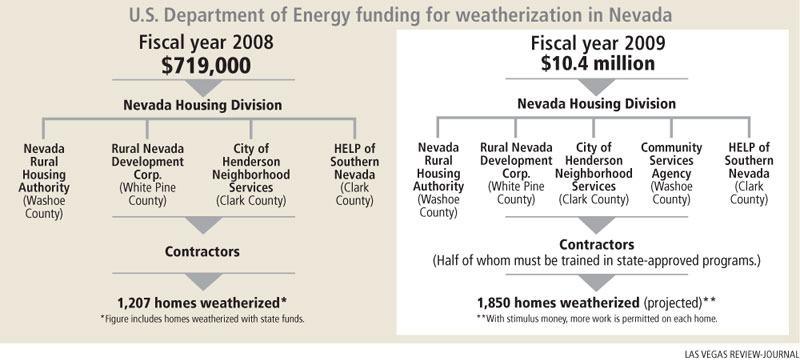PLAN TO WEATHERIZE HOUSES VIA STIMULUS FUNDS HITS SNAGS



When Nevada learned it would get $37 million in federal stimulus to help low-income households cut energy costs, state officials zeroed in on expanding existing and largely successful weatherization programs.
But things haven’t gone exactly to plan.
Fighting over allocation of the money has delayed distribution of the funds that would be used to lower residential utility bills and create hundreds of weatherization jobs for contractors. The biggest squabbles have centered on concerns from state Senate Democrats and the Nevada AFL-CIO that the Nevada Housing Division won’t follow state law by training unemployed workers to do those jobs.
Late this week, the Housing Division was finally able to distribute the first $10 million of the $18.5 million thus far available from the Energy Department.
Ferrel Hansen, CEO of the Rural Nevada Development Corp., a nonprofit group in Ely that is slated to get about $700,000 for residential weatherization, said he hasn’t been able to spend a penny.
"I don’t care whose fault it is," Hansen said. "The clock on this is ticking. We want to go out and help people who need help, and we haven’t been able to."
The AFL-CIO has dropped a challenge after receiving assurance from the state attorney general the weatherization program would comply with state law.
The effort now is to determine which contractors should be hired to do work.
Leslie Paige, spokeswoman for Citizens Against Government Waste, a Washington watchdog group, said she isn’t surprised by the weatherization struggles in Nevada. The same thing is happening everywhere, she said, and can be attributed to a $5 billion weatherization stimulus that is "bloated" and "questionable to begin with."
"I suspect we’ll look back on this later and determine we spent a whole lot of money on this without much return," she said.
Hilary Lopez, chief of federal programs for the Housing Division, said her office plans to add five contract staff positions to help monitor weatherization work, perform on-site inspections and track how groups spend the stimulus funds. In addition, Gov. Jim Gibbons created a "stimulus czar" position to oversee the entire $2.2 billion in stimulus money allocated to Nevada.
The federal Low Income Weatherization Assistance Program was created in 1976 to help low-income households use less energy for cooling, heating and other energy services through insulating homes and installing energy-efficient appliances.
Last year, more than $3 million for weatherization in Nevada came from a state weatherization fund, compared to less than $1 million from federal coffers. With recovery-act funds, however, Nevada will get an annual average of about $10 million for weatherization over the next three years.
Currently, households with a gross income at or below 200 percent of federal poverty income guidelines are eligible for federal weatherization assistance. That means a household of five with an annual income less than $51,580 could participate in the program.
The average cost for weatherizing a home with federal weatherization funds will be about $5,000, according to Housing Division documents.
Nevada’s weatherization program got high marks last year in an evaluation that concluded the program "makes a real difference for Nevada households." The review by H. Gil Peach & Associates LLC of Beaverton, Ore., said the program excelled at tracking how nonprofit agencies spent weatherization grant money.
Last year, about 1,200 homes were weatherized in Nevada. That number is expected to rise to about 1,900 a year.
The disbursement of weatherization funds became a point of contention between the Gibbons administration and Senate Democrats on the Interim Finance Committee, in light of the recent passage of Senate Bill 152, which mandated that the stimulus funds be used to train or retrain workers to perform weatherization projects.
Senate Majority Leader Steven Horsford, D-Las Vegas, said earlier this month the Housing Division was violating the new state law by not hiring weatherization workers from state-approved apprenticeship programs, some of which will be run by unions and community colleges. Horsford and other members of the Interim Finance Committee voted to delay release of weatherization funds.
The committee relented at an emergency meeting on Monday, paving the way for weatherization funds to start flowing.
"This is about having an open, transparent and inclusive process that will allow more contractors to do work," Horsford told the Review-Journal after Monday’s meeting. "We have more money for weatherization, and that will provide chances for more contractors."
The Nevada state AFL-CIO, whose legal challenge to the weatherization program was dropped on Thursday, plans to make sure the Housing Division creates weatherization training programs and that contractors pay prevailing wages, which are usually union scale, and offer some kind of health insurance to employees, said Danny Thompson, state AFL-CIO secretary-treasurer.
Charles Ruiter, president of Ruiter Construction, a nonunion company that has gotten weatherization contracts for several years, said the disputes have left him in limbo. Ruiter said he found 15 of his 19 workers from the local unemployment office and trains them himself.
"The purpose of the bill is to put people to work, and that’s exactly what I’ve been doing," Ruiter said. "I’d like to keep doing it."
Albert Weiss, the weatherization program manager for HELP of Southern Nevada, another of the grant recipients, was out earlier this week watching a family’s home in North Las Vegas being weatherized with existing state funds. The project is expected to trim more than $400 off the family’s annual utility costs.
Nevada Energy estimates that for every $1 invested in weatherization, residents get an average return of $1.39 in savings.
Five agencies, two each in Clark and Washoe counties and one in White Pine County, have received grant agreements: HELP of Southern Nevada, Henderson Neighborhood Services, Nevada Rural Housing Authority, Community Services Agency, and the Rural Nevada Development Corporation.
Now that the first set of funds has been released, Lopez of the Housing Division hopes all the controversy and bickering are finally over.
"Our goal is to get funds out into the community, to employ people, and to weatherize homes," she said.
Contact reporter Alan Maimon at amaimon@reviewjournal.com or 702-383-0404.
FIND OUT MOREThose seeking weatherization help can contact one of the following organizations:
HELP of Southern Nevada
702-369-4357
www.helpsonv.org
Service area: All of Clark County except for Henderson
Henderson Neighborhood Services
702-267-2000
www.cityofhenderson.com
Service area: Henderson
Rural Nevada Development Corporation
775-289-8519
www.rndcnv.org
Service area: 11 rural Nevada counties
Nevada Rural Housing Authority
775-887-1795
www.nvrural.org
Service area: Carson City and Lyon, Douglas and Storey counties
Community Services Agency
775-786-6023
www.csareno.org
Service area: Reno/Carson City


















